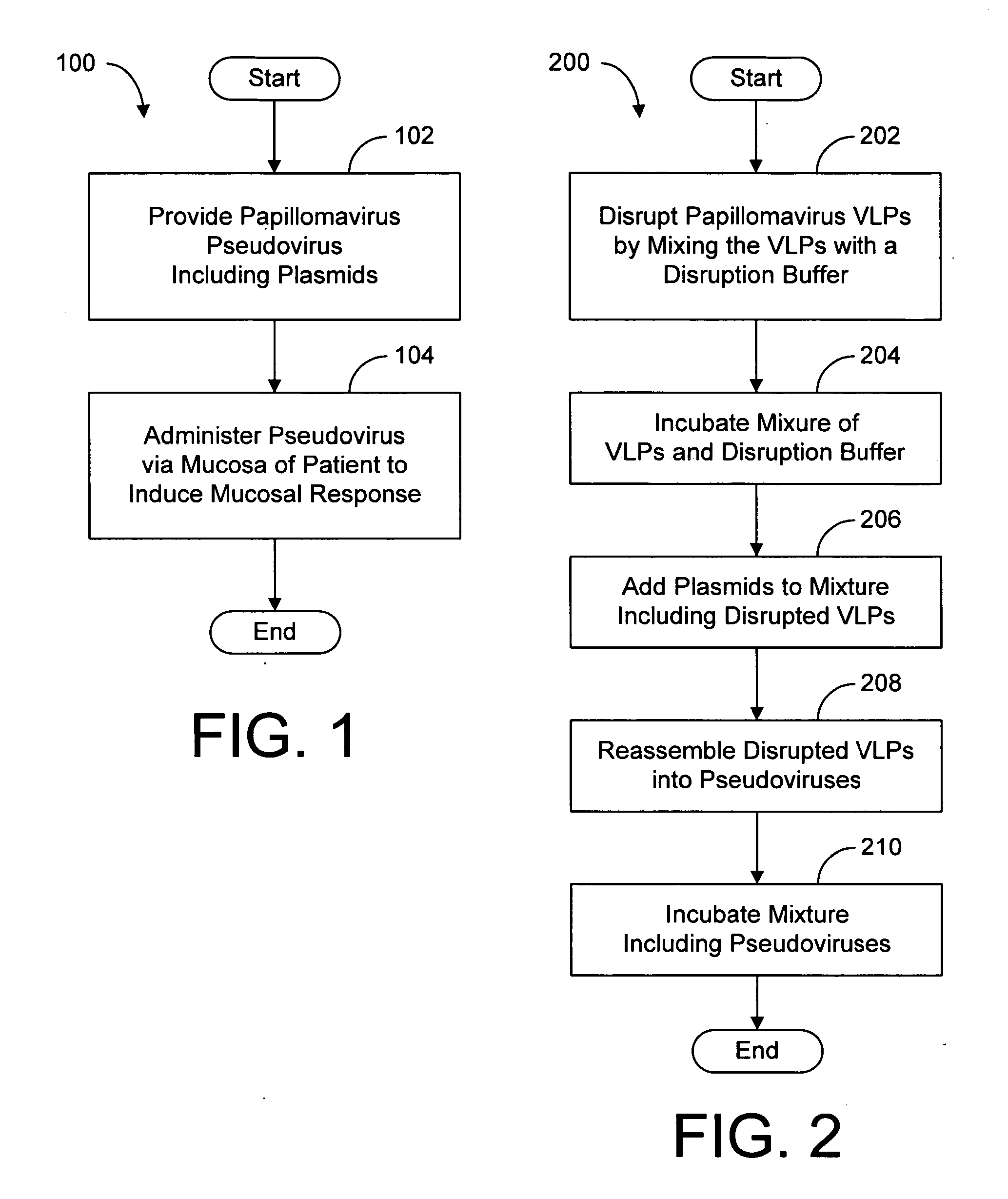Papilloma pseudovirus and preparation
- Summary
- Abstract
- Description
- Claims
- Application Information
AI Technical Summary
Benefits of technology
Problems solved by technology
Method used
Image
Examples
example 1
[0011] First, HPV-VLPs were mixed with disruption buffer at 1:1 proportion by vol., and then incubated at room temperature for 60 min. The disruption buffer was composed of ethylene glycol bis(2-aminoethylether) tetraacetic acid (EGTA) 20 mM, dithiothreitol (DTT) 40 mM, sodium chloride (NaCl) 300 mM, and Tris-hydrochloric acid (Tris-HCl)(pH 8.0) 100 mM. Then, the plasmids (pCI-GLP-LCMV) were added into the mixture in 0.5 microgram / microliter by ratio of 1 / 10 in vol. Next, stop buffer was progressively added, and the mixture was incubated at 4 centigrade overnight. The stop buffer was composed of calcium chloride (CaCl2) 25 mM, and dimethyl sulfoxide (DMSO) 20% (in vol.). The pseudovirus was subcutaneously injected into C57BL6 mice. Meanwhile, the unpackaged plasmids were injected directly into mice as a control. It was found that the pseudovirus induced more CTLs than the unpackaged plasmids did by using Cr51 release assay or gamma interferon Elispot. The conclusion is that the pseu...
example 2
[0012] First, BPV-VLPs were mixed with disruption buffer at 1:1 proportion by vol., and then incubated at room temperature for 60 min. The disruption buffer was composed of EGTA 20 mM, DTT 40 mM, NaCl 300 mM, and Tris-hydrochloric acid (Tris-HCl) (pH 8.0) 100 mM. Then, plasmids expressing GLP (Green lantern protein) were added into the mixture in 0.5 microgram / microliter by ratio of 1 / 10 in vol. Next, the same volume of stop buffer was gradually added, and the mixture was incubated at 4 centigrade overnight. The stop buffer was composed of CaCl2 25 mM, and DMSO 20% (in vol.). The pseudoviruses were orally administered into mice, and the expression of GLP was examined. GLP was found in intestinal mucosa, mesenteric lymph nodes, and spleen. It is thus demonstrated that the pseudovirus can carry genes to intestinal mucosa and the entire immune system. Therefore, it can be used in gene therapy. When mice were orally administered with unpackaged plasmids encoding GLP, GLP was not found i...
example 3
[0013] By the same method as described in example 1, a pseudovirus expressing HPV16E7 (HPV and BPV pseudoviruses) was prepared and given to mice orally. The pseudovirus induced specific mucosal and systemic CTLs to the E7 antigen. However, oral immunization with unpackaged plasmid encoding the E7 could not induce any immune response. Therefore, the pseudovirus can be used to induce mucosal and systemic immune responses.
PUM
 Login to View More
Login to View More Abstract
Description
Claims
Application Information
 Login to View More
Login to View More - R&D
- Intellectual Property
- Life Sciences
- Materials
- Tech Scout
- Unparalleled Data Quality
- Higher Quality Content
- 60% Fewer Hallucinations
Browse by: Latest US Patents, China's latest patents, Technical Efficacy Thesaurus, Application Domain, Technology Topic, Popular Technical Reports.
© 2025 PatSnap. All rights reserved.Legal|Privacy policy|Modern Slavery Act Transparency Statement|Sitemap|About US| Contact US: help@patsnap.com

